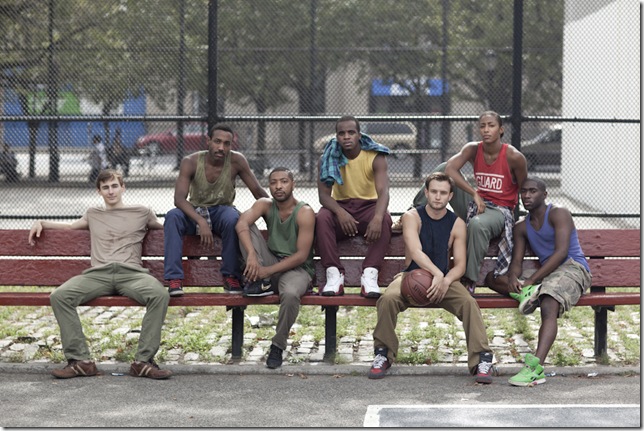By Tara Mitton Catao
Kyle Abraham took careful aim at gun violence and suppression in his powerful and intimate portrayal of life in the historically black Pittsburgh neighborhoods of East Liberty, Homewood and the Hill District where he grew up.
In a short time, Abraham has established himself as an award-winning choreographer (last year, he received a so-called “genius grant” from the MacArthur Foundation) and as an artist who has a unique and resounding choreographic voice that needs to be heard.
This past weekend, P.E.A.K. (Provocative Entertainment at Kravis) presented Pavement, Abraham’s exceedingly timely, evening-length work, performed by Abraham in Motion, a group comprising seven consummate artists — Abraham, Matthew Baker, Winston Dynamite Brown, Jeremy Neal, Maleek Washington, Eric Williams and Tamisha Guy, who as the only woman performer added the female perspective to the work.
The Rinker Playhouse proved to be a good venue for this interdisciplinary production, with its stage stripped bare to the walls creating a revealing and intimate setting in which Abraham fashioned and filtered his perspective of the city’s black population from its more prosperous era in the 1950’s to today’s gang-controlled streets.
With the recent focus in the news about inner-city violence between African-Americans and the police, Pavement put us right in the center of it. Abraham took on the ultimate role of an artist which is to assist us — to assist society — to see another view of life that requires us not only to think and but also to question.
Originally inspired by John Singleton’s groundbreaking 1991 movie Boyz N the Hood, and fueled by his ongoing quest to understand his identity in relation to his personal history, Abraham is a broad-based and supremely creative artist whose work in Pavement engaged the audience in a very deep and personal way.
With a clear theme of “Hands up. Don’t shoot,” the work was intriguingly less violent and intense than one might have expected. Instead there was a complexity, richly layered but provocatively diffused. In a unique sense, it had refinement that opened different doors for thought-provoking interpretations. The dancers’ movement was constructed into continuous motion like the rhythm of city life but the movement vocabulary had a visceral style that was personal, sensual and distinctive. The ample stillness throughout the work, most notably at the end where, prone on the floor, the dancers barely moved for three songs, resonated just as forcefully as the flurries of motion.
The gray rectangle of the stage simply depicted the hard, paved, surface of a city basketball court where everyday situations unfolded and the pulse of young black men’s interactions were sensitively but not exploitively explored. The code of the street and the pressure of ever-present violence seemed to force them to take stances that rippled through the group.
In juxtaposition, the sound score — as it yanked us from one era to another with its over 23 different artists as well as sound bites from police radios and the painful human sounds of mourning — created another dimension for us to interpolate. The unusual pairings to the sound were very effective: the castrato-like voice of Philippe Jaroussky to the weighted masculine dynamics of the dancers; the lyrics of Fred McDowell’s “What’s The Matter Now” to the sensitive introductory solo by Abraham; the onstage dialogue “Help me. Come on, you know me… help me” to the group dancing lit only partially by a flashing red light (reminiscent of of a near-by police car); and the uncomfortable scene of someone slowly eating a bag of chips next to a prostrated body.
The carefully selected choices continued with the small screen that was the backboard of the basketball hoop, showing video images and shoefiti (sneakers flung on a wire to signal the territory of drug dealers). Most interactions were fleeting and subtle but there was a resonating image of a gesture that permeated the work. It was of hands being pulled behind the back and being placed face to the floor. It was so predominant that one grew uncertain if it was meant to be forceful, submissive or even tender. As it became more and more practiced, it seemed almost ritualistic and perhaps even a way to gain personal space.
The beauty of art is that, though what it depicts might not be beautiful, it gives us a unique and focused view through the human lens of the artist. The artistic quality of the work of Abraham and A.I.M. was front row and center. The performers were excellent actors as well as powerful dancers.
With such high-quality work to be seen — that which crosses the lines, crosses the barriers and leaves us with a better perspective — it was very frustrating to see so many unfilled seats while the streets just outside the theatre were teaming with a wide spectrum of people searching for something to occupy them.
